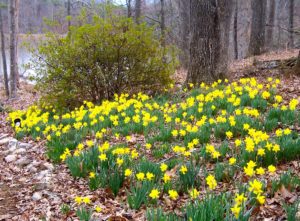By Joe Ketterer
 There was a time when it was SOP (standard operating procedure) to compliment a fall flower rotation with a spectacular array of colors by planting spring flowering bulbs. This practice has almost completely fallen by the wayside as a result of the last couple of recessions. With a rebounding economy and an ongoing demand for attention-grabbing flower displays, it’s time to bring back the feeling of exuberance early spring flowers can provide.
There was a time when it was SOP (standard operating procedure) to compliment a fall flower rotation with a spectacular array of colors by planting spring flowering bulbs. This practice has almost completely fallen by the wayside as a result of the last couple of recessions. With a rebounding economy and an ongoing demand for attention-grabbing flower displays, it’s time to bring back the feeling of exuberance early spring flowers can provide.
 Tulips are guaranteed bloomers only in their initial season, which is why we consider them as annuals and recommend planting them at the same time as fall flowers such as pansies or violas. With an immense pallet of colors and heights available, tulips provide endless design opportunities. One of our favorite techniques is using tulips as an accessory to an existing bed of pansies or violas by planting them in the rear third of the bed as a backdrop in either a contrasting or complementary color. This has a number of benefits:
Tulips are guaranteed bloomers only in their initial season, which is why we consider them as annuals and recommend planting them at the same time as fall flowers such as pansies or violas. With an immense pallet of colors and heights available, tulips provide endless design opportunities. One of our favorite techniques is using tulips as an accessory to an existing bed of pansies or violas by planting them in the rear third of the bed as a backdrop in either a contrasting or complementary color. This has a number of benefits:
- This strategy can require fewer flowers, which helps keep costs down. (The correct spacing for planting tulips is four bulbs per square foot to produce the desired effect at a nominal cost.)
- It adds significant impact by creating another “layer” or “tier” of interest.
- Tulips as an accessory serve as an insurance policy in case of a harsh winter where the survivability of pansies or violas might be in question.
- When the tulip blooms fade, it is much easier to remove them from the rear third of the plant bed without disturbing the root systems of the other flowers which continue on until the summer rotation is installed.
But don’t just limit yourself to just tulips when planting bulbs—consider the following varieties:
 Daffodils—These bulbs are consistent bloomers and multiply year over year, making them one of the very best landscape investments. Naturalize them along a wooded edge or mass plant them in beds of groundcover like liriope for a spring explosion of yellow, orange or white.
Daffodils—These bulbs are consistent bloomers and multiply year over year, making them one of the very best landscape investments. Naturalize them along a wooded edge or mass plant them in beds of groundcover like liriope for a spring explosion of yellow, orange or white.- Crocus—These blooms may be small but are considered the “harbinger of spring” and a welcome splash of color in late winter/early spring. Plant them where they can be seen up close and personal.
- Hyacinth—These fragrant flowers last for weeks and are best utilized near entry walkways to take advantage of their scent and come in vibrant hues of pink, blue, and purple.
Unlike tulips, these bulbs should be treated more like perennials and generally should be planted in areas wont they won’t be disturbed by the planting of summer and fall flower rotations. Additionally, while bulb displays in turf can look spectacular, extra care and considerations are needed to insure their longevity.
The coming of spring triggers a desire to get back outside and enjoy what Mother Nature has to offer. There is no better bang for your buck in the spring than using the vibrant colors that spring bulbs offer to create energy and excitement. Fall is the time to plant, so take the time now to consider using bulbs—whether in sweeping waves or just a strategic splash of color—to jazz up your spring landscape.
 Daffodils—These bulbs are consistent bloomers and multiply year over year, making them one of the very best landscape investments. Naturalize them along a wooded edge or mass plant them in beds of groundcover like liriope for a spring explosion of yellow, orange or white.
Daffodils—These bulbs are consistent bloomers and multiply year over year, making them one of the very best landscape investments. Naturalize them along a wooded edge or mass plant them in beds of groundcover like liriope for a spring explosion of yellow, orange or white.